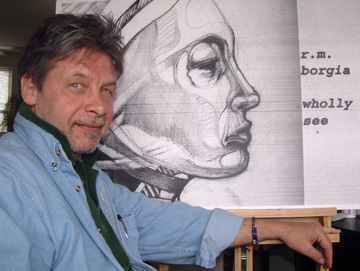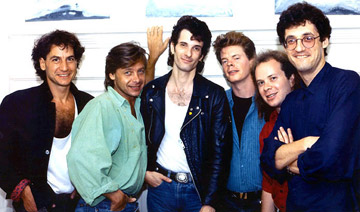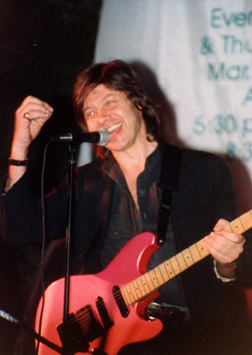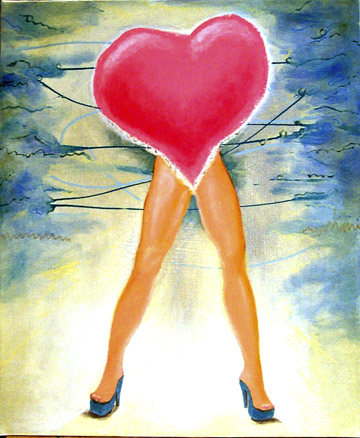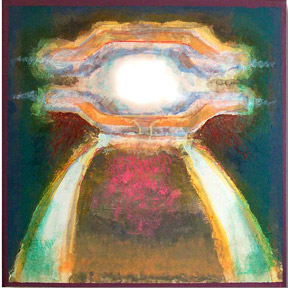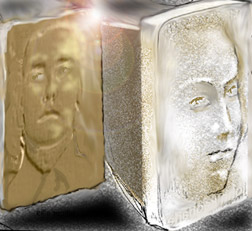
Columbus, Ohio, USA
Return to Homepage www.shortnorth.com
See Hear.
Rick Borgia shares his lifelong affair with two Muses.
by Jennifer Hambrick
May 2006Return to Features Index
Visit Rick Borgia's Web site www.rickborgia.com
Rick Borgia / © photo by Gus Brunsman III Episodes in the life of an artist
Rick Borgia is a difficult man to define. And he likes it that way.
“In many ways my past is an enigma, a patchwork of the duality of entertaining two muses,” Borgia said.
A visual artist, musician, record producer, inventor, Harrison West resident and New York City 9/11 refugee, Borgia has made a career of embracing the full gamut of creative experience. Now he’s brought his unique brand of eclecticism to the Columbus arts scene.
Born on the military base Camp Atterbury in Edinburgh, Indiana, Borgia was raised in Erie, Pennsylvania. His early training in the visual arts, which began at the Erie Art Museum when he was 5 years old, led him to attend the Columbus College of Art and Design from 1969 to 1971.
Yet, even with prestigious artistic training, Borgia never planned to develop a career as an artist. He says his rust belt upbringing never engendered the idea of becoming a professional artist.
“The only ways to live that were presented to me in my life were to join the Army – be a man, fight in the Vietnam war – or get a job in a factory,” Borgia said.
Still, Borgia found artistic and spiritual inspiration in his youth from his father whose drawings he admired, and even working summer jobs in the factories of Erie, Pennsylvania.
“I had some fantastic experiences working in factories,” Borgia said. “I worked at Erie City Iron Works. The saws cut gigantic pieces of metal, and my job would be to sand those off with a 660 RPM grinder.
I got to work with welding. I loved welding – I thought welding was the coolest thing in the world. I worked as a janitor, I cleaned offices, I buffed floors. I remember buffing floors and thinking that was the most Zen thing. You could hold that big floor buffer that went around and around and it made that nice noise and it was your job to create perfection out of that floor.”
After leaving CCAD, Borgia took classes at Mercyhurst College in Erie for a year in 1972. There he continued his creative pursuits, but because he had been an artist since his youth, Borgia says it never occurred to him that he needed to want to become an artist when thinking about how to make a living.
Mink DeVille Band lineup in 1985/86. Photo taken in Winterthur, Switzerland.
From left: Bob Curiano, Rick Borgia, Willy Deville, Shawn Murray,
Seth Farber, Lou Cortelezzi.“I was completely immersed in the wildest creative work and what I thought was my career, but I didn’t even have any concept of career because I never wanted to become an artist,” Boria said. “I already was an artist. I’ve always been an artist, even when I was seven, eight, nine, ten, eleven years old.”
Borgia began taking guitar lessons when he was 11. He had found another art to love, and one that he eventually thought might help support his work in the visual arts.
“When I was younger I thought, the music thing was probably really good because in the art thing, you really had to have some kind of patron or be the son of a diplomat to get involved with huge productions. So I said, Let me see if I can build some residual income by getting involved in music. And I thought to myself, Is this a result of me cheating one – thinking that the activity of one could support the other?”
Borgia moved to New York City in 1973 to work with the Intermedia Art Center and played guitar and sang backup with local bands. He was recruited for the band Mink DeVille and played with that band for the next seven years, living for part of that time in Holland and touring with the band in the United States and Europe.
“It was a truly old-fashioned rock ’n‘ roll band that dabbled in Latin rhythms, traditional do-wop vocals added, Cajun influence added to the music, soul. It just wasn’t that popular in America, but we did fairly well in Europe between 1979 and 1986 as a band. The European audiences loved it because it really had a more American roots music vibe to it and a bluesy vibe to it.”During his Mink DeVille years, Borgia continued working in both music and visual art. In a sense, these years laid the foundation for the eclectic artistic lifestyle he still enjoys.
Rick Borgia at the South Street Seaport Music Festival, NYC, in 1988, performing with the soul band Big Fun. “When I would come back to New York after being on tour in Europe, I would pick up freelance art and graphic work in between tours,” Borgia said. “That’s how they all came together at the same time. I can’t imagine being in the Rolling Stones, for example, where you tour 200 or 300 days out of the year and played “Brown Sugar” every night. I did enjoy the variety in the fact that we were so different. It was just so rich and colorful. It had a gypsy atmosphere to it, complete with shrouds, tinsel and candles and magic talismans. It was off the hook. It was an interesting, wonderful cultural excursion. It was an amazing thing to have been able to do that and still live to tell about it.”
An artist’s artist
Borgia stayed in New York City after Mink DeVille disbanded in 1986, pursuing his interests in art and music. He blended his study and experience in the visual arts and music and, in 1987, launched Hypnotech Productions, a business providing creative support for Fortune 500 companies. In this capacity Borgia composed music for special corporate productions, films and television commercials, and fundraisers. He also produced recordings for established record labels, including guitarist Richard Leo Johnson’s Fingertip Ship, which Borgia produced for Blue Note Records.It was his work for Hypnotech Productions that confirmed his career as a collaborative artist who supports the work of other artists – an artist’s artist, a creative person who is fascinated by the creative process in all its forms. Borgia’s belief that the very act of collaborating on artistic projects is in itself a healing experience is the inspiration for much of his work.
“When I engage in collaboration, it’s healing for me, and it can be a very powerful metaphor for the individual I’m working with to gain self-respect, to gain understanding of self, to reflect on positive abilities that may exist,” Borgia said. “The intrinsic value of the person is brought out. You yourself can have an experience that is profound. Or a conundrum that has been on your mind – Why did this happen? Some place in your personal story, your own personal history, where there was a question that was never answered – you may find a way to move through that. When I do a portrait of somebody, there’s an interaction with the portrait where I want to worship that particular personality and characteristic of that person that I find in them, and I want to amplify what they can reflect on, so that they can get a sense of identifying with a higher self.”
It was in the spirit of the artist-healer that Borgia created his first recording of his own music, Sky Blue Pink (2004). Inspired by his desire to assist in providing music therapy for his youngest brother Jonn, who suffered a traumatic brain injury in 1994, the ambient/trance compositions are designed to be experienced as an hour-long soundtrack for alternative healing modalities.
Borgia’s belief in the greater powers of the creative process led him to study the creative process itself at the Monroe Institute in 2004, a center specializing in the exploration of human consciousness. Borgia brought a copy of Sky Blue Pink with him on his stay at the Institute, thinking its healing and refreshing qualities was in line with the Institute’s work and philosophy. The Institute offered him a contract to re-produce Sky Blue Pink for their Metamusic series. The new disc sells under the title Reflections (2005) and is identical to Sky Blue Pink except that it has been embedded with the Hemi-Sync signal, an electro-acoustical signal designed to synchronize the two hemispheres of the brain and to bring the mind to a highly focused, near meditative state.
“Hemi-Sync is just one more example of how music and technology have come together to offer some kind of relief from stress, offer a different relationship to listening than what was previously the role of music,” Borgia said. “It’s not supposed to replace prayer or meditation. Basically, it applies frequencies that we don’t hear, that exist but that are below our threshold of perception, that are used with the music to create this synchronization of the hemispheres.”
Borgia’s ideal for Reflections – to bring people into a state of complete, self-less openness so that healing can emerge and unleash creativity – was intended to offer an alternative to the ubiquitous background music that he often hears as just so much ego-injected clatter.
“(Reflections) is designed to not be listened to,” Borgia said. “There’s very little in this that says, ‘Listen to me. Here’s my personality. This is what I want you to understand about my personality.’ It was created and designed – if I was able to touch you, or if I was able to hold somebody, this is how I would do it with sound, with music. There’s not much that’s going to come out at you and say, ‘Hey, what a great guitar player that guy is,’ or ‘Wow, that’s genius.’ It’s welcoming and nurturing.”
Big Heart, Nice Legs, 20" x 24" acrylic on canvas, 2006, by Rick Borgia.
This painting depicts two familiar shapes joined at the hip.Borgia is currently working on a number of recording projects with Columbus musicians, including singer/songwriter Eileen Motok, singer Elmer Fisher and sitarist and jazz guitarist Hans Utter. Utter, whose six recordings embrace traditional Hindustani as well as pop and Hip Hop idioms, elected to collaborate with Borgia on one of his current recording projects because they both wanted to produce music that could enhance people’s lives in a significant way.
“(Borgia) had a similar conception in terms of how he’s approaching music in general and approaching art,” Utter said. “You could say, he looks at it as a way to create positive types of energy and as using it for healing. I’m trying to move away from music that I feel doesn’t have a higher purpose, that doesn’t have anything beyond getting a product on the shelves. The projects I’m working on now I would at least hope have some other benefits that go beyond selling something. I’m trying to tap into spiritual or energetic types of experiences.”
Borgia also has continued his work in the visual arts, especially painting. He has most recently been working on a series of paintings featuring the figure of a giant pink heart atop a pair of shapely women’s legs. Borgia plans to continue to develop this concept into something that is at once immediately appealing to people and recognizable as the ‘Borgia style.’
“I think the metaphor is that I want you to see that we’re love beings,” Borgia said. “My goal with these paintings is to achieve some really great work that communicates all the love that I sense a painting can do. It’s also an attempt to find some way to blend the things that I like into a series that could be popular enough to be a style. I like the female form and the heart shape is very popular. So I’m just putting these things together. It’s about inventing a symbol that’s modern, that’s old-fashioned, the retro feeling of the pretty legs.”
Because he has resisted specializing in any particular branch of the arts and has claimed the whole world of creative activity as his domain, Borgia says he has found it difficult if not impossible to label himself. He once tried to give himself a title based on his work as an artist of multiple dimensions.
“I came up with Animorphic Creative Processor, the idea that everything is moving and it all can be interrelated,” Borgia said.
But he admits that this title still does not convey to others the many aspects of what he does. This he hopes to accomplish through Wholly See Productions, a concept still in the process of being developed that Borgia says will encompass the full range of his artistic endeavors.
Renaissance Man
But it is unlikely that Wholly See Productions will include only Borgia’s interests in the arts, the creative process and its link with higher spirituality, no matter how broad these interests already may be. In the true spirit of a Renaissance Man, Borgia has created designs for any number of futuristic projects that yoke the arts with technology and science to expand the current realm of human experience.
Past Life Regression Portal #29, 20" x 20"
acrylic on canvas, 2005.Borgia’s interest in the arts and technology finds its most extreme expression in his concept of the Past Life Regression Portal, an installation piece that Borgia says would combine all the advances in surveillance and biotechnology. An individual would view a picture of himself through the portal while sitting in a chair embedded with various types of biometric technology.
“His reactions to this image brings the next level of going back in time,” Borgia said.
“My concept for that is really more born out of a desire to create an experience that is based in conceptual art and using all the technologies that are used in other purposes in accomplishing an experience for the viewer in an art audience,” Borgia said. “It was sort of a tongue-in-cheek thing for me to do.”
In a more serious vein, Borgia also sought to bring technology and the arts together in a design he submitted for consideration for the World Trade Center memorial. Borgia, who was in New York City when the September 11, 2001 terrorist attacks occurred, saw the towers collapse and, along with millions of others that day, was dumbfounded by the devastation.
“I can hardly even believe that I saw the buildings go down,” Borgia said. “It just doesn’t seem possible. It bent your reasoning and your understanding of what we know of reality to see this happening. It was a beautiful day, and the amount of stuff that was coming from lower Manhattan was the size of a glacier. It was just so thick. It was so physical, mountain-like in its solidness – it just didn’t seem like smoke. It just seemed that the cloud that was coming from Manhattan grew and grew and grew. You could hear the sound of the cloud moving. It was like a grindingness that was hardly perceptible. 9/11 was and still is a subject that is on my mind on a daily basis.”
It is difficult not to see Borgia’s design for the World Trade Center memorial as his own attempts to grasp the enormity of the September 11 attacks. In the design, a DNA helix winds through a park. Computer-generated bas-relief likenesses of each person who perished at the World Trade Center that day, and audio clips, taken from answering machines, of each of their voices, unfold in a timeline around the park.
“It was my way of unifying everybody who at that moment joined,” Borgia said. “I perceived that whenever something happens to end someone’s life without having any time to prepare for it their body stops, but whatever was going on with them doesn’t stop. That exists in the form of the connections to all the other people that were there at the time.”
Illustration from WTC Memorial project.
Computer generated bas-relief images of
WTC victims in bronze and aluminum.The September 11 terrorist attacks were what ultimately caused Borgia and his wife Rieah Masubuchi to leave Manhattan in 2001. Convention and corporate event activity slowed drastically in New York City in the immediate wake of the attacks, bringing Borgia’s industry to a near standstill. He and Masubuchi moved first to Erie, and then to Detroit before relocating to Columbus when Masubuchi’s employer transferred her to the area in January of 2005. Borgia says they found a good replacement for their former Manhattan lifestyle in the Short North.
“We went to the Short North really because of its art and cultural significance,” Borgia said. “To us it was like moving to the west village of Manhattan. We didn’t have that villagey type of feeling in Detroit at all. So we thought, that would be cool. I was very excited about the relatively large amount of galleries for a midwestern city. We ended up in a fine place.”
Today, Borgia finds himself at work in the recording studio on the lower-level of his home, now dabbling on canvases in his upper-level artist’s workspace. One flight of stairs separates the two domains which for Borgia are part and parcel of who he is.
“Both music and art have always been almost equally a fundamental part of who I am,” Borgia said. “That’s why I’m an artist and a musician who has worked so many different areas in creative design, production, music, graphic art, art direction, creative direction. Way more things than you need to do in one lifetime. That’s the theme basically: that all things are possible. Being a master at one thing is a very honorable pursuit, but I was never able to choose a specific genre of art or of music that I wanted to limit myself to. I’m a pan-artist. I’m not bored with painting. I’m not bored with the creation of music. I’m unbored. I’m unborable. I am also very, very grateful.”Visit www.rickborgia.com or call 614-299-1233
©2006 Short North Gazette, Columbus, Ohio. All rights reserved.
